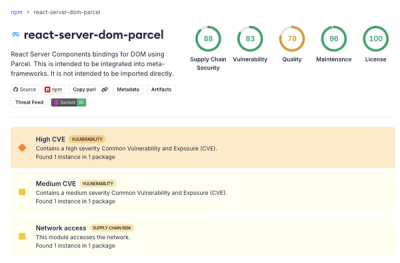
Security News
Deno 2.6 + Socket: Supply Chain Defense In Your CLI
Deno 2.6 introduces deno audit with a new --socket flag that plugs directly into Socket to bring supply chain security checks into the Deno CLI.
pancakes-angular
Advanced tools
The purpose of this plugin is render HTML and generate JavaScript code that uses AngularJS syntax on both the client and server. There are three major pieces to this repo:
TBD
npm install pancakes-angular
The idea behind the transformers is simple. Take isomorphic code and transform it into client side code. The steps are as follows:
Much of the code here can/should be overriden by an app written on top of pancakes. However, there are a couple key pieces that are used as the foundation of the generated code. This includes:
The first thing to realize with rendering AngularJS on the server is that we are only interested in rendering the initial page. We don't care about any AngularJS code executed after the initial load or which is only used to help bootstrap AngularJS on the client.
Also, certain things like routing and utilities (i.e. AngularJS services) are developed in a generic way (see panckes documentation for more details on these), so there is no need for doing an Angular-specific translation.
What is left then?
FAQs
Pancakes plugin for Angular
We found that pancakes-angular demonstrated a not healthy version release cadence and project activity because the last version was released a year ago. It has 3 open source maintainers collaborating on the project.
Did you know?

Socket for GitHub automatically highlights issues in each pull request and monitors the health of all your open source dependencies. Discover the contents of your packages and block harmful activity before you install or update your dependencies.

Security News
Deno 2.6 introduces deno audit with a new --socket flag that plugs directly into Socket to bring supply chain security checks into the Deno CLI.

Security News
New DoS and source code exposure bugs in React Server Components and Next.js: what’s affected and how to update safely.

Security News
Socket CEO Feross Aboukhadijeh joins Software Engineering Daily to discuss modern software supply chain attacks and rising AI-driven security risks.